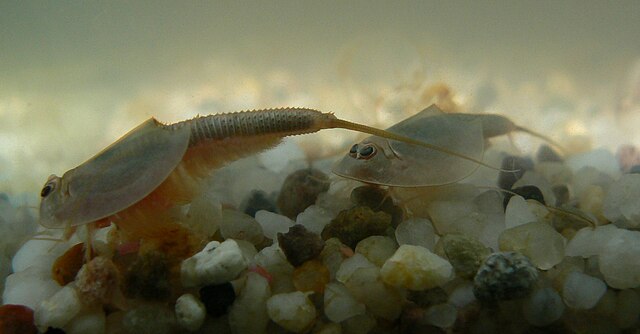
What is a tadpole shrimp? It is a species of crustacean and is actually one of the oldest known animal species. It is called a living fossil because it is so old.
The Latin name for the tadpole shrimp is Notostraca, and their genus is triops, which means three eyes because they have two compound eyes and a third eye that they use for detecting light. Tadpole shrimps are not actually tadpoles and they are not shrimp either. They have a shape that is similar to tadpoles, hence that name, and they have legs and a body that resemble a shrimp, hence that name. They are between 2 and 11 cm long and they are mostly the same shape as a regular shrimp except for their carapace. The carapace is the upper part of the exoskeleton, just over where the shrimp’s head is. The carapace on the tadpole shrimp is big and flat and sweeps backwards, giving them their distinctive shape.
There are several things that make tadpole shrimp fascinating. I want to look at four of them: their age, their eggs, how they breathe, and what they eat,
The fossil record shows that tadpole shrimp have existed in their current form since the end of the Devonian Era, which was about 360 million years ago. This is why they are called living fossils. This makes them the oldest living animal because every other animal that was alive at the same time has gone extinct. At the end of the Devonian, the Earth was divided into two supercontinents and the first creatures were coming out of the sea and starting to live on land. However, even though they are called “living fossils” they have actually evolved and are not exactly the same as the earliest examples. Their body shape has remained pretty constant, though.
The eggs of the tadpole shrimp are fascinating as well. The eggs are also one of the reasons why the tadpole shrimp as been able to survive for so many millions of years. Tadpole shrimp lay about 200 eggs a day, but they only live for about three months. Most of the eggs hatch very quickly, become baby tadpole shrimp, and then grow very quickly. However, not all of the eggs hatch. A percentage of them dry out and go into diapause, which means that they stop developing and basically go into stasis. The egg they are in hardens to protect then. In this form, they can survive for many years, get blown all over the place, and even pass through the digestive tract of animals, all in one piece. When they find themselves back in the water, they rehydrate and start developing again. Often, the places the tadpole shrimp live in experience prolonged droughts. With the ability to survive being dried out, the tadpole shrimp can last through times that might wipe out other animals.
Tadpole shrimp have an interesting way of breathing. They live in the water, but they don’t have gills. They breathe through very primitive leaf-like extensions that hang off their legs. These leaf-like structures are very small and they are a very basic form of gills. The structures are outside the body and in contact with the water, allowing them to absorb oxygen directly out of it. These primitive gills work much better than real gills in the ponds where the shrimp live because the water levels are low and they dry up very quickly.
The final thing is what and how they eat. Tadpole shrimp sound amazing, but they are actually something of a pest. They are omnivores and they eat small fish, small shrimp, and aquatic plants. They don’t live for very long and they grow extremely quickly, so they have to consume about 40% of their body mass in food every day. This makes them a pest. They live in shallow water and they are only a pest when they invade rice paddies. They are found in many places that grow rice and they are such a pest that pesticides are often used. The problem is not that they eat the seeds. The problem is that they find food by digging up the soil on the bottom of the pond and when they do this they can cut or uproot the rice seedlings planted there. Another problem is that they stir up the sediment, making the water very murky and that stops light from getting to the seedlings, stunting their growth. Fascinating creatures. And this is what I learned today.
If you liked this, try these:
Sources
https://ucanr.edu/blogs/blogcore/postdetail.cfm?postnum=52339
https://ucmp.berkeley.edu/devonian/devonian.php
https://www.nbcnews.com/news/all/ancient-tadpole-shrimp-not-really-living-fossil-flna1c9180553
https://en.wikipedia.org/wiki/Notostraca
https://triopsking.com/Triops-Longicaudatus
https://www.naro.affrc.go.jp/archive/niaes/techdoc/apasd/Triops%20%20spp%20-B.html
Image By NalesnikLD – Own work, Public Domain, https://commons.wikimedia.org/w/index.php?curid=7573976
